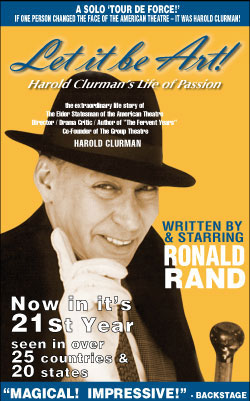Carolyn D. Palmer
Carolyn Palmer working on Lucille Ball for Lovable Lucy sculpture
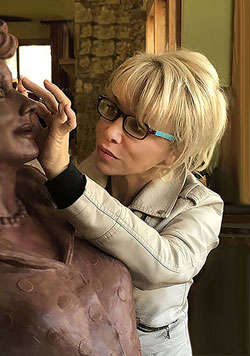 An accomplished sculptor, many of her works are displayed in prominent museums and public venues as well as in various private collections across America and the world. Ms. Palmer’s work includes bronze busts of Franklin and Eleanor Roosevelt in the main lobby of the Franklin D. Roosevelt Presidential Library and Museum in Hyde Park, New York. She also created a marble bust of Pope Francis displayed in the entrance of the Papal Residence in New York City for his visit to the U.S. in 2015. The Holy Pontiff performed a special benediction over the sculpture. Her first bronze edition of Pope Francis is in Saint Patrick’s Cathedral in NYC. Ms. Palmer also created sculptures of Thomas Jefferson for the prestigious Jefferson Center in Syracuse New York, and sculptures of Orville and Wilbur Wright at the Sanford Orlando Airport in Florida. She also sculpted a life-size bronze figure of Lucille Ball for Lucy's hometown in Jamestown New York. Ms. Palmer's sculptures can also be seen in the television series, Madam Secretary.
An accomplished sculptor, many of her works are displayed in prominent museums and public venues as well as in various private collections across America and the world. Ms. Palmer’s work includes bronze busts of Franklin and Eleanor Roosevelt in the main lobby of the Franklin D. Roosevelt Presidential Library and Museum in Hyde Park, New York. She also created a marble bust of Pope Francis displayed in the entrance of the Papal Residence in New York City for his visit to the U.S. in 2015. The Holy Pontiff performed a special benediction over the sculpture. Her first bronze edition of Pope Francis is in Saint Patrick’s Cathedral in NYC. Ms. Palmer also created sculptures of Thomas Jefferson for the prestigious Jefferson Center in Syracuse New York, and sculptures of Orville and Wilbur Wright at the Sanford Orlando Airport in Florida. She also sculpted a life-size bronze figure of Lucille Ball for Lucy's hometown in Jamestown New York. Ms. Palmer's sculptures can also be seen in the television series, Madam Secretary.
When did you first know your path lay in creating sculptures?
While growing up in Orange County, NY, we’d vacation at my grandparents in Florida where I’d sculpt sand people on the beach. I was so young yet I had this huge passion for creating faces and figures. People gathered in amazement watching my little hands sculpt. I didn’t feel the faces were that good, but their reactions gave me a clue that I had some kind of innate gift.
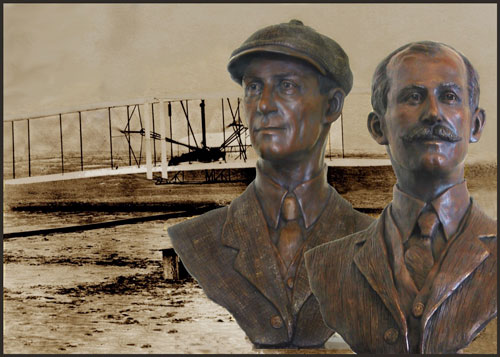
Wright Brothers by Carolyn Palmer
First I became a portrait painter, and in 2002, a friend, who owns the Thomas Jefferson Center in Syracuse, called asking about a painting of his son. He also asked if I could find someone to sculpt a bronze Jefferson for his building. I was so excited that I asked if I could first take a shot at the sculpture with a preliminary clay model for his approval. I said, “If you don’t like the figure, you don’t have to pay me.” This was my first statue so it was thrilling, yet extremely intimidating. Every now and then, he would stop by to see the sculpture in progress and thankfully he was very happy about how it was coming along.
Thomas Jefferson by Carolyn Palmer
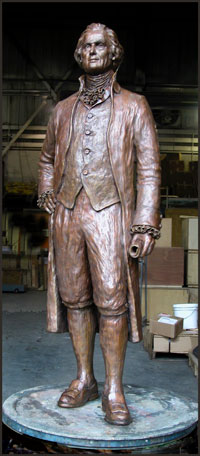
There were no photographs of Jefferson so the only available images were from the paintings created by other artists. I wanted to research and create my own rendition based on how Jefferson was described in books: it was said that he stood six feet-two-and-a-half inches tall, was strong as a horse, with a powerful square jaw. The profile on the nickel was another reference along with how other sculptors portrayed him. The French sculptor, Houdon, actually had Jefferson sit for him but I liked Rudolph Evan’s rendition at the Jefferson Memorial because it was closer to how Jefferson was described by his peers. When the sculpture was finally completed, I received tremendous positive feedback which brought a big sigh of relief!
I had no idea my future would be as a sculptor. I just had a huge passion to create this Thomas Jefferson and it seemed like other commissions just sort of found me so I went with it. Now I can’t imagine a life without sculpting. You wonder what path you will go down and mine was found a little late in life, but I guess you can say we all leave our own “fingerprints in the sand.”
I understand you make only nine molds of each sculpture. Is that part of a tradition?
The traditional sculptor typically made just one mold from their original sculpture, and from that one mold they would create an edition of nine castings and keep a few artist copies for themselves. I like following that tradition unless I’m commissioned to create a “one of a kind” sculpture where the mold is basically destroyed. But a limited edition that is numbered gives a sculpture a certain prestige; a rare quality especially when there are only nine in the entire world.
You created masterful sculptures of President Franklin D. Roosevelt and Eleanor Roosevelt displayed in the renovated lobby of the FDR Presidential Library and Museum. What kind of preliminary work did you do?
FDR by Carolyn Palmer
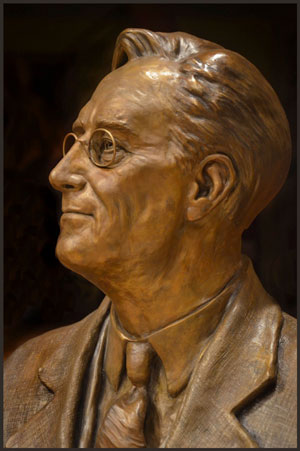 For the Roosevelts, I researched their personalities and various moods found in countless photos. I felt Eleanor was such a special lady exuding inner beauty. Although her mother and others commented on her homely looks, I focused on Eleanor’s compassion and honesty along with her determination. Eleanor was actually quoted as saying, “No matter how plain a woman may be, if truth and honesty is written on her face, she will be beautiful.” I aimed to give Eleanor that very beauty she spoke about.
For the Roosevelts, I researched their personalities and various moods found in countless photos. I felt Eleanor was such a special lady exuding inner beauty. Although her mother and others commented on her homely looks, I focused on Eleanor’s compassion and honesty along with her determination. Eleanor was actually quoted as saying, “No matter how plain a woman may be, if truth and honesty is written on her face, she will be beautiful.” I aimed to give Eleanor that very beauty she spoke about.
I used many reference photos, studying the light and shadows on their faces and then I’d simulate the same lighting in my studio. For example, if FDR had lighting from the left, I would aim my studio lighting form the left to study the lit up facets of his face and its shadows. I then sculpted to create shadows exactly where they were in the photographs.
I understand you also made the sculptures touchable for the blind.
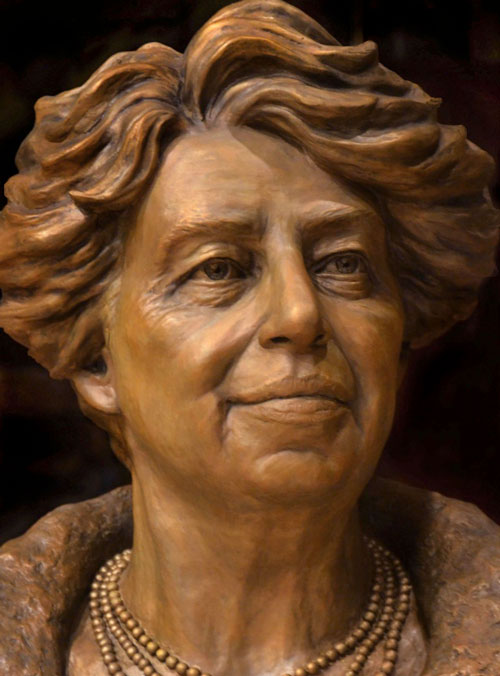
Eleanor Roosevelt by Carolyn Palmer
Yes. This was such a powerful gift! When I was first commissioned, the Director of the Library asked if it was ok for the blind to touch them. I was thrilled and it opened up a whole new dimension to my work. While sculpting, I would periodically close my eyes to feel each sculpture in a more sensitive way. I began to feel with both hands and could easily discern the nuances of the anatomy or feel if the planes weren’t symmetrical. I started to call forth their likenesses just by feeling with my hands.
Now, from that point forward, whenever I work on a sculpture, I’ll close my eyes and feel the forms and textures of various parts of the body to see if it feels like a real face, arm or an authentic leg; it’s truly been a gift of sight!
How long did it take you to create your memorable sculpture of Pope Francis for the Papal Residence in New York City. And as you worked on it, did you have music playing to help create a certain mood?
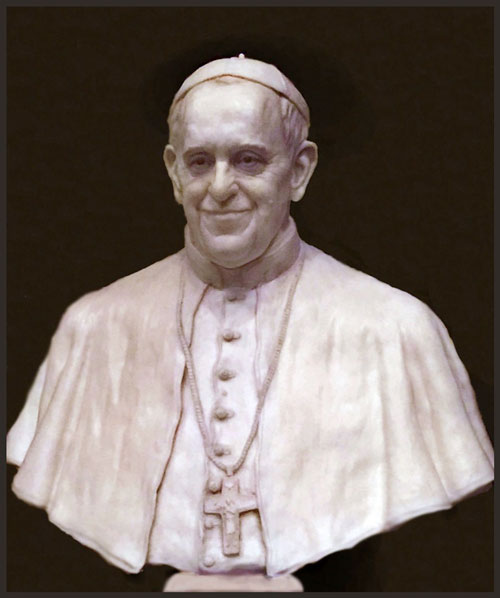
Sculpture of His Holiness Pope Francis by Carolyn Palmer
It took me about six months to sculpt the Holy Father. To create the mood, I played lots of chamber and spiritual music, in particular, classical choral pieces by a group called “The Priests.” I spent days looking at photos of Pope Francis. It took longer than expected for me to be pleased but he finally showed up in a way that I liked.
When I complete a sculpture it’s really open for the viewer’s interpretation. I’m never totally satisfied with a piece and if there wasn’t a deadline, I would never find completion. It’s as Leonardo da Vinci said: “Art is never finished, only abandoned.” I always feel that way.
What were you seeking to include of Lucy’s personality when you created your sculpture of Lucille Ball?
I wanted to portray the glamorous Lucy exuding confidence with a little bit of her playful side. My vision was to have her walking onto her Hollywood star saying, “Here I am!” I think “peacocking” her dress with her right hand adds a certain playfulness to it, while the left hand sits confidently on her hip dangling a purse.
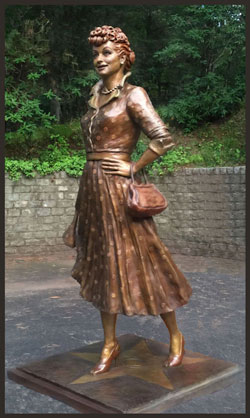
Lucille Ball by Carolyn Palmer
Also, I wanted to show the stylish Lucy; collar turned up and scrunched up sleeves, with pleated and signature polka dot dress. I gave her a pearl necklace and earrings. She even has a petticoat showing. Sculpting her face to find the spirit of Lucy was both fun and challenging. I endured many sleepless nights. You just hope the public is pleased with your work.
Of course, sculpture has a long lineage stretching back thousands of years to the Greeks and the Egyptians and no doubt even further back to the dawn of man, and whether one is enthralled either by Michelangelo’s Pieta and his David, or work by Rodin, Houdon, Elisabet Ney, Jo Davidson or modern sculptors including Louise Nevelson, Alexander Calder, Louise Bourgeois and Isamu Noguchi, sculpture is a great expression coming from an artist’s vision. How was your vision shaped and what are your greatest goals in creating life in a sculpture?
In Hinduism, the embodiment of a god or a person can live in a sculpture, they call it a “Murti,” and this is also practiced in many cultures around the world. I really believe a statue can touch the viewer with its inner spirit. While sculpting, I am always thinking of the person’s spirit, probably more than their personality.
My goal is for the viewer to have an emotional experience of that person. I’m learning all the time not just by studying people but also by studying others that came before me. When I look at a bust by Jo Davidson or Jean-Baptiste Carpeaux, I feel moved, especially by Carpeaux, in the way he captured movement and people’s personalities, which is all so inspiring to me.
Overall, I believe our love and passion for a piece of art creates a special bond or communication between us and what we’re viewing. When art moves us, a shift occurs that brings us to a higher plane. I think of all good art as spiritual experiences.
What I do, I do mostly for others, not for myself. My creations are a way of contributing to the world – and to hear people talk about how they’re moved by viewing a sculptures I’ve created – I feel humbled, and ecstatic; that’s the greatest gift of all.
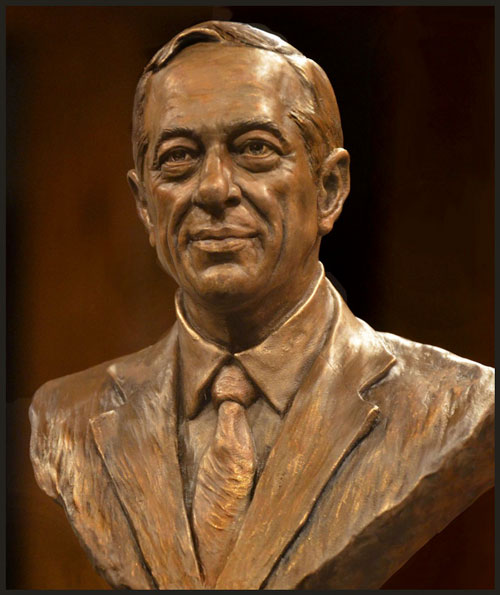
Governor Mario M. Cuomo by Carolyn Palmer

























